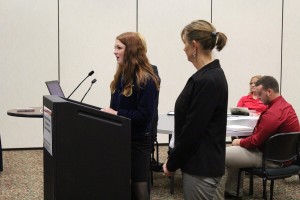WOOSTER, Ohio — A group of ag educators and students made suggestions to the Ohio House Agriculture and Rural Development Committee Aug. 26, about ways to help close the teacher shortage gap.
Over the past few years, the demand for high school agriculture educators has increased, due to a multitude of factors that include changes to the state funding structure for technical education, re-assignment of existing high school ag teachers, retirement of ag teachers, and changes within ag curriculum itself, which now attracts a more diverse group of students.
The USDA estimates there will be 60,000 ag job openings annually, and only 35,000 graduates to fill them, said Graham Cochran, interim chairman of Ohio State University’s Department of Ag Communication, Education and Leadership.
Teacher shortage
Cochran said the nation is facing a teacher shortage in general, and that same trend runs parallel in the “lack of qualified people available and interested in teaching agricultural education in America’s public schools.”

Cochran said OSU offers the only four-year public degree program for preparing secondary and middle school ag educators.
Wilmington College, a private school, also offers this degree, and is seeing similar trends as Ohio State.
Monte Anderson, area chairman for agriculture at Wilmington, said enrollment in secondary and middle school ag programs continues to increase — as more students see career opportunities and take interest in “knowing where their food comes from.”
The ag student curriculum has also changed — with less focus on production agriculture, and more focus on technical sciences.
More students
Whitney Short, ag educator and FFA adviser with the Anthony Wayne High School-Penta Career Center program in northwest Ohio, said the changes in curriculum have resulted in an increase in student enrollment. Her program went from 90 students, to 180 this year.
And it’s not just farm students.
“We are teaching less production agriculture and more biotechnology and agriscience-based courses,” she said. “… We are teaching future experts in the health field, research, mechanics, engineering, electricity, environmental science, food science, and additional in-demand fields.”
Those testifying suggested a wide range of ideas to draw more qualified teachers to the profession.
One is to increase salary. Anderson said many ag graduates are finding starting jobs that pay as much as 20-25 percent more than teaching jobs, and are making decisions based on income.
Offer incentives
A potential solution, he said, is to offer state-level scholarships for students who return to teach in their home state. That worked well for Anderson, who said he achieved a scholarship in Illinois, in exchange for his commitment to teach in that state upon graduation.
Another challenge is the workload and stress of being an ag teacher.
Although most ag teachers enter the profession because of their passion for agriculture and teaching — their passion gets put to the test amid long hours, student projects, contests and events.
Rachael Ramsier, a former ag educator, told the committee that she found herself working more than 60 hours a week — doing things she loved, but in a way that became too taxing on her personal life.
According to Short, and the Ohio Agricultural Education Team, 15 percent of ag education positions have not yet been filled for the current school year, and 56 percent of the teachers who have been hired are new to the profession.
The hearing was held at the Ohio Agricultural Research and Development Center in Wooster, which works with college students at the adjoining Agricultural Technical Institute — to train future educators.
Jim Kinder, interim director at ATI, said overall enrollment is up to 763 this fall, and the number of students pursuing agriscience education degree is up, as well.











